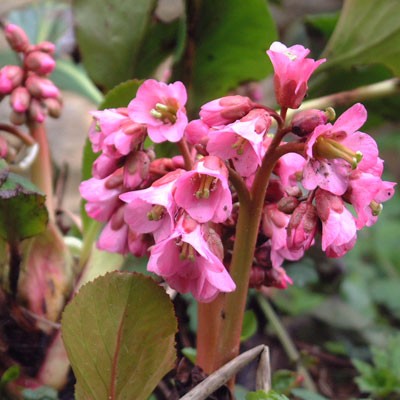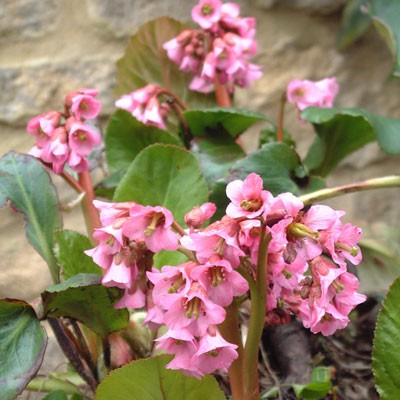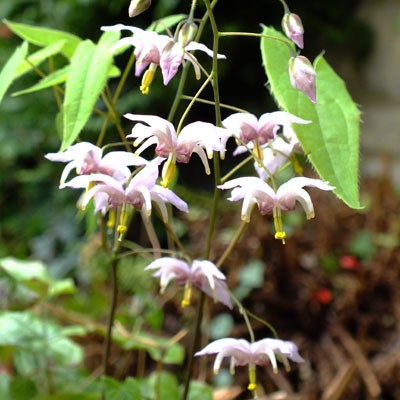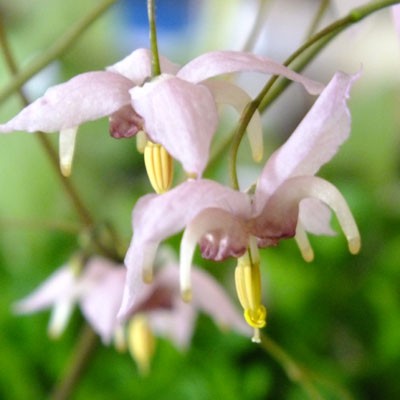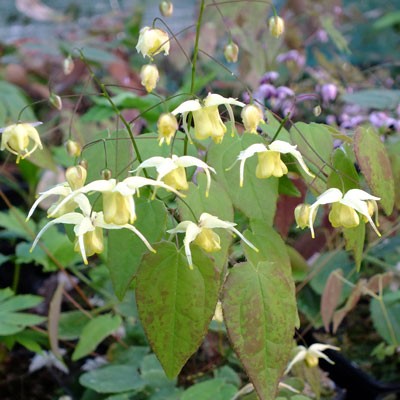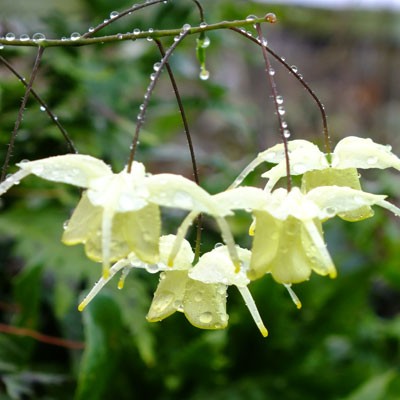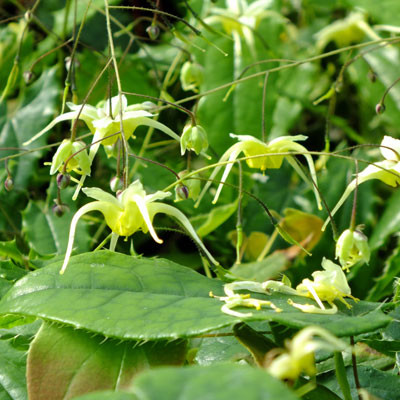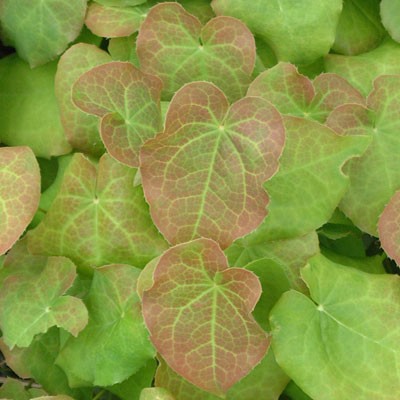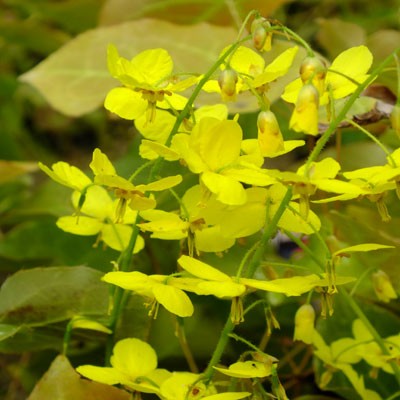-
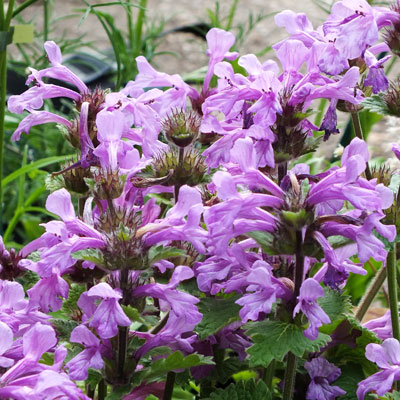


Bee Friendly
Potsize - 1L
Whilst the heart shaped leaves make good muted green ground cover, it is the flowers are remarkable. In shape and colour they are very like the heads of betony, if a little paler, but they are borne on short stalks and are of a large size quite out of proportion with expectations. A first rate plant for the front of the border. No where near as rampant as its cousin, Stachys lanata. Plant in sun for good flowering. 30cm Discount of 25p per plant for quantities of 3 or over -

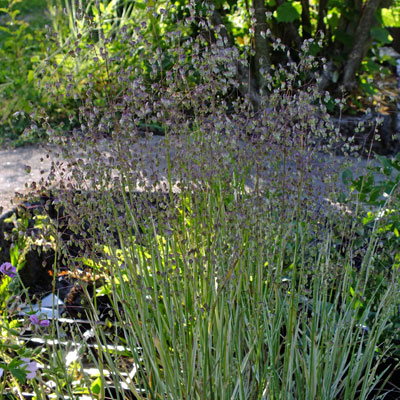
Potsize - 1L
A pretty quaking grass with tidy mounds of soft glaucous leaves with handsome white edges and striping. In Summer, dainty wands of little dancing lockets are produced which sway in the breeze. Green-white at first and often tinged with pink, the seed heads become golden with age. Semi-evergreen clumps of leaves. Not a very long lived plant but careful regular division can extend its life. Seedlings do not come true. 50-70cm in flower, 30cm in leaf.Discount of 25p per plant for quantities of 3 or over -
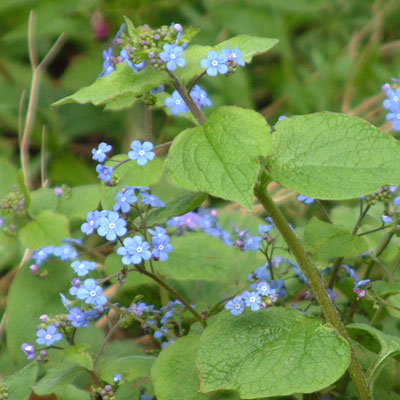
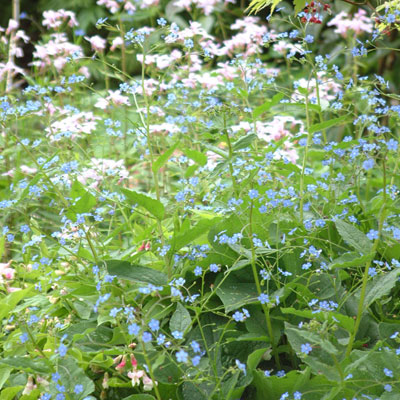
Potsize - 1L
Siberian Bugloss. A brilliant perennial which grows well in dry shady places, but will excel in most reasonable positions. Large heart-shaped felty green leaves make a stout clump topped in Spring with a cloud of tiny forget-me-not flowers. Hardy and reliable and one of those plants that ought to find a place in every garden. 30-45cmDiscount of 25p per plant for quantities of 3 or overLinks
Brunnera Compared
Botanical Style Photographs
-

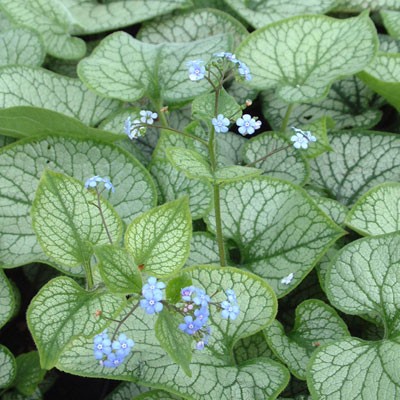

RHS AGM
Potsize - 1L
Brunnera macrophylla 'Jack Frost'. Coarsely hairy, heart-shaped leaves are heavily silvered and picked out by dark green margins and veins, making fascinating patterns not unlike an intricate cathedral window. A picture from Spring to Autumn especially when given shade and adequate moisture to prevent scorching in high Summer. The Spring display is further enhanced by an airy cloud of icy-blue forget-me-nots on stems decorated with smaller but similarly marked leaves. 50cmLinks
Brunnera Compared
Botanical Style Photographs
-
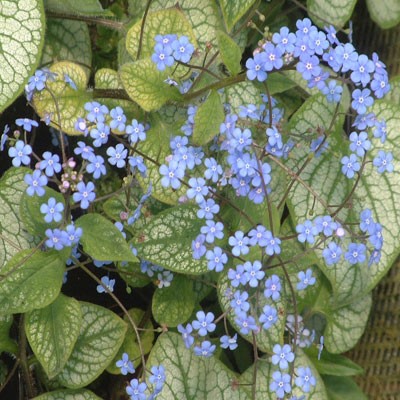
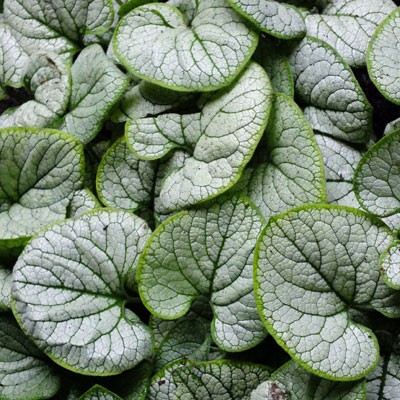
Potsize - 1L
Brunnera macrophylla 'Silver Heart'. A new introduction (2012) by Spilsbergen-Willemsen from the Netherlands. Superficially like a more silvered version of the popular Jack Frost, but generally considered to be a tougher more sun resistant variety on account of the thicker character of the leaves, which can also grow larger in size. Coarsely hairy, heart-shaped leaves are heavily silvered and picked out by dark green margins and veins, making fascinating patterns not unlike an intricate cathedral window. A picture from Spring to Autumn especially when given shade and adequate moisture to prevent scorching in high Summer. The Spring display is further enhanced by an airy cloud of icy-blue forget-me-nots on stems decorated with smaller but similarly marked leaves. 50cm plusLinks
Brunnera Compared
Botanical Style Photographs
-
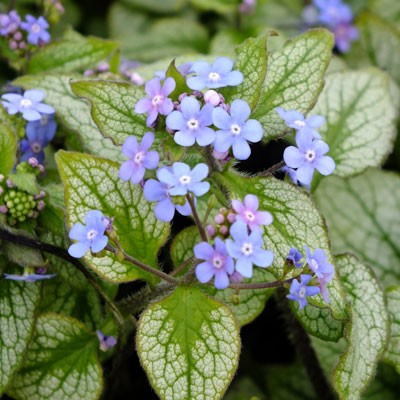
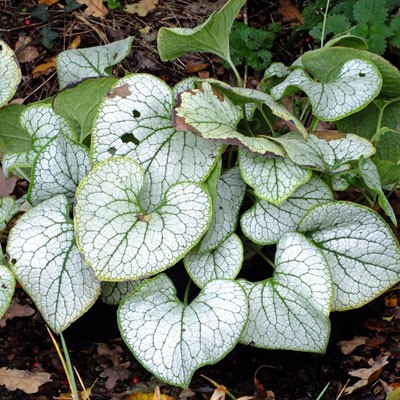
Potsize - 1L
Very similar to the ever popular Brunnera 'Jack Frost' except that it is a little whiter and has an elongated pointed tip to the leaf. Leaves are a lovely silver with the veins picked out in green forming a dense mound in any situation that is out of direct sun. Clouds of blue forget-me-not flowers in Spring.Links
Brunnera Compared
Botanical Style Photographs
-

Potsize - 1L
A compact and very free flowering form of our native clustered bellflower. Dense mats of foliage producing stiff stems to 20cm tall with a dense globular cluster of rich purple-blue bells at the top. Good in full sun and on chalky soils.Discount of 25p per plant for quantities of 3 or overLinks
Campanula Compared
Botanical Style Photographs
-
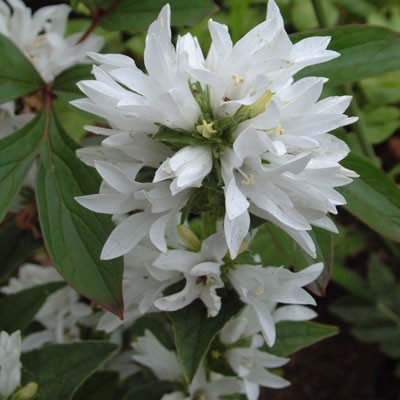
Potsize - 1L
Clustered Bellflower. Pure white flowers are clusterd at the top of the 30cm stems as well as in the axils of the leafy bracts along its length. A compact glistening white form of one of our native bellflowers. Native across most of Europe, including England where the purple form grows wild on chalk downs. Elsewhere it grows in hedge margins and in mountain meadows. 30cm, June to August. Good for cutting and for bees.Discount of 25p per plant for quantities of 3 or overLinks
Campanula Compared
Botanical Style Photographs
-
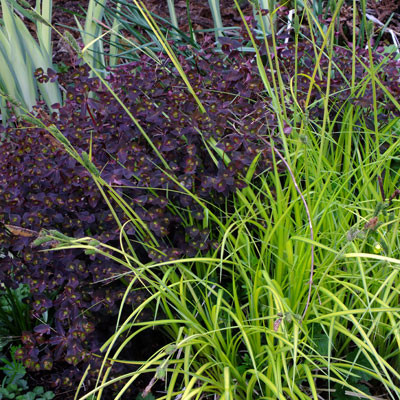

Potsize - 1L
Bowles' golden sedge. Like everything that carries Bowles' name, this is a good reliable little gem. This sedge is compact and tidy, looking good for the majority of the year, but looking at its best in late Spring. The foliage is longitudinally striped green and dominant yellow, brightest in Spring becoming deeper yellow in Summer. The flowers come early, small stiff bottle brushes held upright above the leaves. Comb out old foliage to tidy up once a year. 50-75cm. Best in a moist soil, not for dry sites.Discount of 25p per plant for quantities of 3 or over -


Potsize - 1L
In late Oct this tight 2-3ft mound is smothered in 1in pom-poms; shaded apricot to maroon. Very welcome so late in the year. Any soil in sun. Cut to ground in winter.Links
Botanical Style Photographs
-
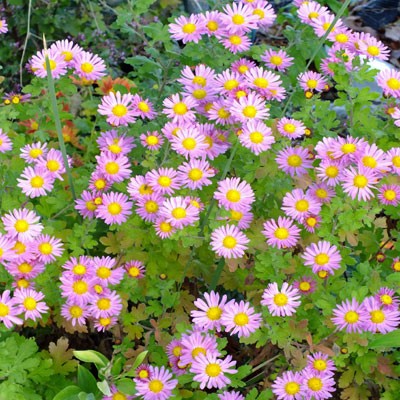
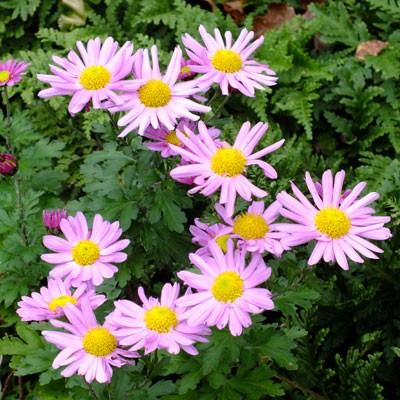

RHS AGM
Potsize - 1L
To me, this Chrysanthemum shows the same qualities as C.'Innocence' in that it is so weatherproof. It puts up with wind, rain and even the first frosts without becoming scruffy. It puts on a show of its single pink blooms from October until as late as December in a good year. About 60cm high and with the usual lovely Chrysanthemum scent. reliable and long-lived.Links
Botanical Style Photographs
[/fusion_separator -

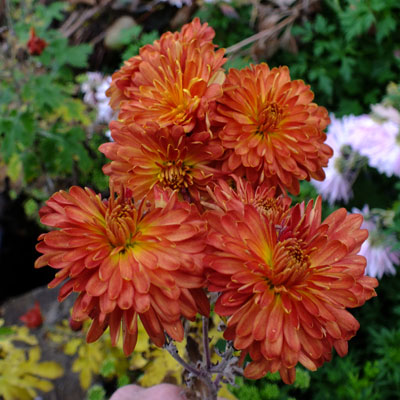
Potsize - 1L
A particularly strong growing variety that is very late into flower, regularly flowering from October and into December. The 6cm flowers are fairly well double, even when fully open the centre has a yellow glow, but no central disc. The petals are a rich burnt orange with enough of an incurve to show a pale apricot reverse. Very similar in tone to Paul Boissier.Links
Botanical Style Photographs
[/fusion_separator -
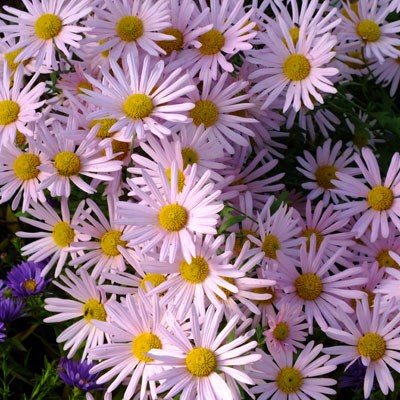
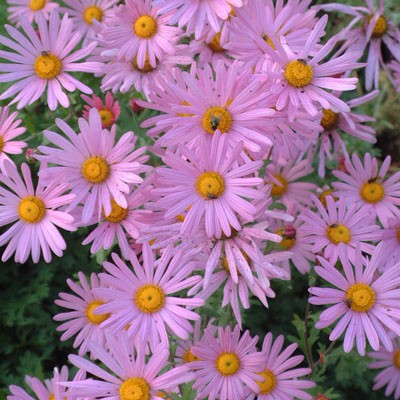
Potsize - 1L
Chrysanthemum 'Clara Curtis' (Korean: single 21d). Very free flowering and hardy chrysanthemum. with 3in clear sugar pink flowers produced profusely from August to October. Cut to ground in Winter. Any soil. 60cm. MAY CAUSE SKIN ALLERGYLinks
Botanical Style Photographs
-
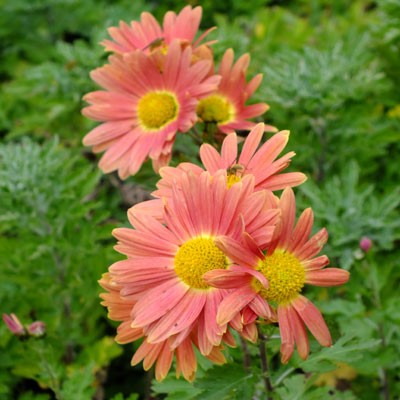

Potsize - 1L
Chrysanthemum 'Cottage Apricot' has single, but full flowers which shade from an apricot edge to a burnt orange centre. As the flower ages, the colour becomes stronger, being far more a coppery red than the apricot of its name. It has a rich heady honey scent.Links
Botanical Style Photographs
-
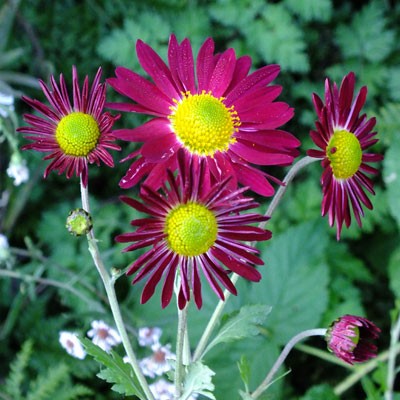
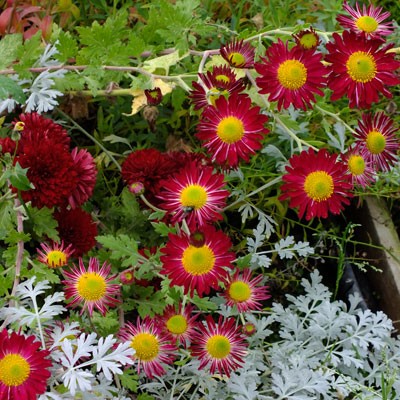

RHS AGM
Potsize - 1L
Intensely magenta pink single blooms with a distinctly pale ring surrounding the bright yellow central boss. Reminiscent of a dark red Pyrethrum but flowering in October-November. About 60-70cm tall. Lovely Chrysanthemum scent.Links
Botanical Style Photographs
[/fusion_separator -
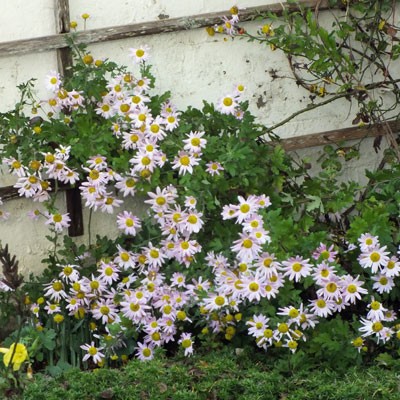
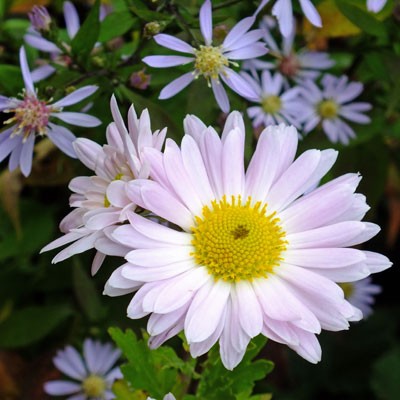
Potsize - 1L
Full petalled single flowers which are white with a flush of pinkLinks
Botanical Style Photographs
-
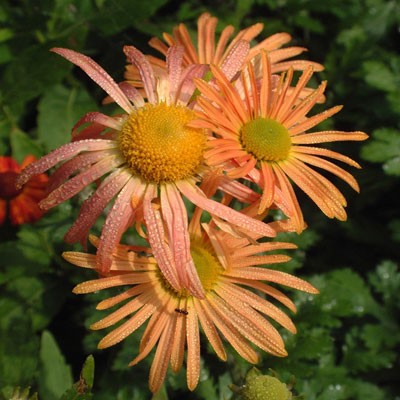
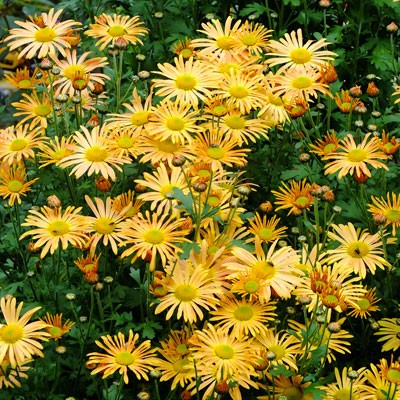
Potsize - 1L
Very free flowering and hardy chrysanth. with 3in soft apricot flowers produced profusely from August to October. Cut to ground in Winter. Any soil. 60cm. MAY CAUSE SKIN ALLERGYLinks
Botanical Style Photographs
-
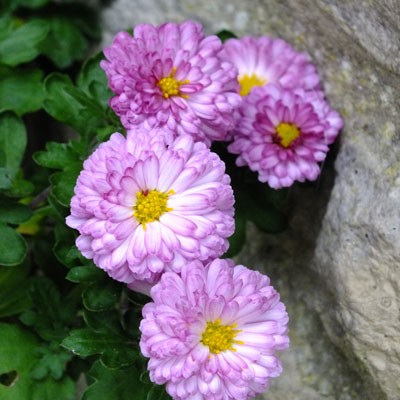
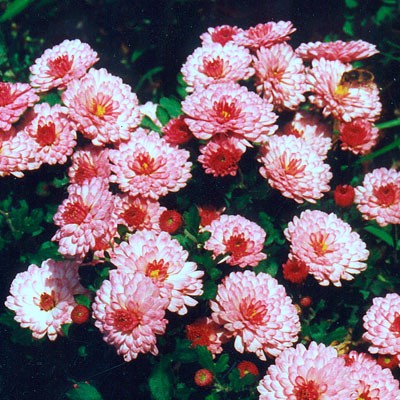
Potsize - 1L
Very welcome in late Oct this tight 2-3ft mound is smothered in 1in pom-poms; shaded light to dark pink. Any soil in sun. Cut to ground in winter. MAY CAUSE SKIN ALLERGYLinks
Botanical Style Photographs
[/fusion_separator -
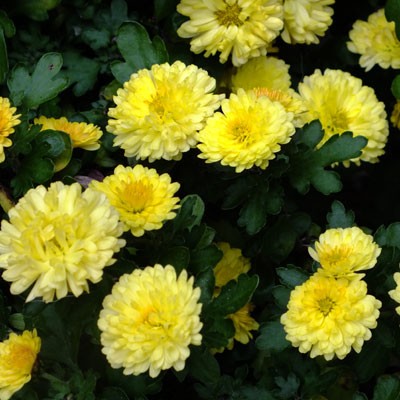

Potsize - 1L
Sunshine yellow buttons at the end of the season are the mark of this variety. It flowers early in the Chrysanthemum season and forms a low 60cm bush that is absolutely covered in bright yellow fully double buttons that deepen in colour from the edge to the centre.Links
Botanical Style Photographs
[/fusion_separator -
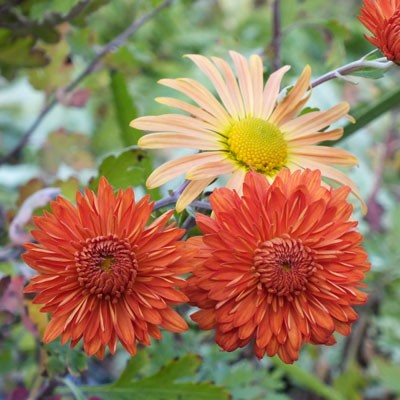

Potsize - 1L
Chrysanthemum 'Paul Boissier' has double flowers in a glowing rich copper, beginning with classic Japanese painted regularity, later opening further to reveal a central eye. It is just the perfect embodiment of the subtle beauty of golden Autumn sunshine on freshly fallen beech leaves. Nice honey scent. Will probably require stakingLinks
Botanical Style Photographs
-
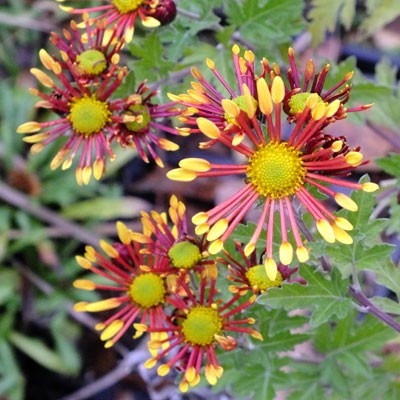
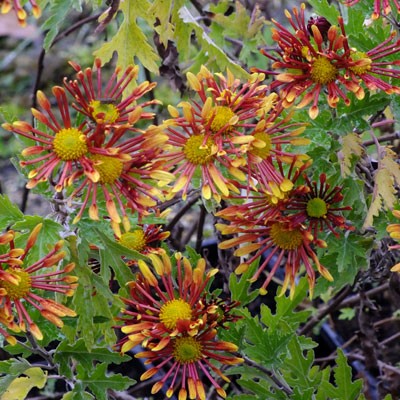
Potsize - 1L
A really distinctive variety that has a great charm. The petals are quilled with a slightly broader tip. The shafts of each petal are red with the exposed upper surface at the tip a bright yellow.Links
Botanical Style Photographs
-
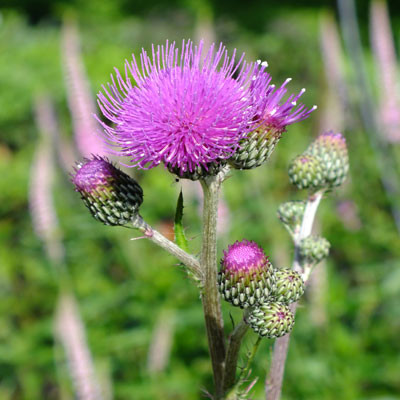

- Butterfly Friendly
- Bee Friendly
Potsize - 1L
Queen Anne Thistle. This is a native thistle from Europe, being found right across into Russia. It's no shrinking violet, but unlike some of the other members of the Cirsium genus it tends to stay put in one place and not become 'weedy'. It grows a generous basal rosette of largely non-spring leaves and throws up tall branching flower spikes up to 2m plus topped with generous thistle-knobs at the top. If you have the space its a great statement plant and great too for the wildlife, providing nectar for insects, seeds for the finches and a food plant for Painted Ladies. For a moist soil.Discount of 25p per plant for quantities of 3 or overLinks
Botanical Style Photographs
-
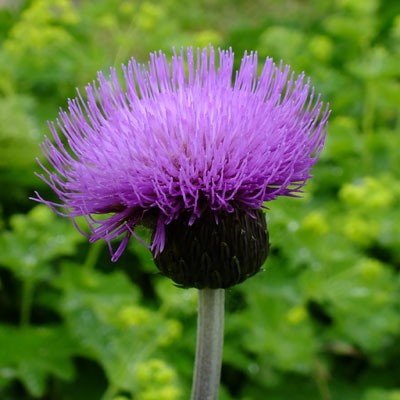
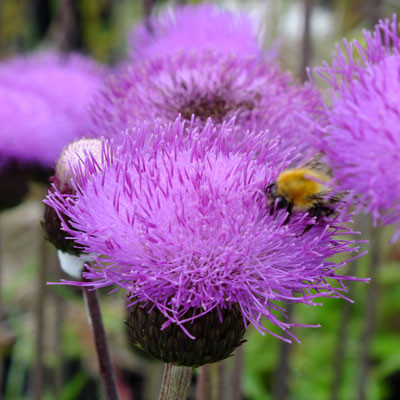
- Butterfly Friendly
- Bee Friendly
Potsize - 1L
Melancholy Thistle. Broader leaves, a more spreading habit and larger flowers than its cousin Cirsium rivulare. Later in the year to flower as well. The reason for the name heterophyllum comes from the variability of the leaf form, which becomes more divided on the flowering stalks than the basal rosettes. In shade this plant will grow well but flower poorly. Give it plenty of moisture and sun to see it at its best. The plant was considered a possible cure for sadness. Nicholas Culpepper in 1669 said that it "makes a man as merry as a cricket" Discount of 25p per plant for quantities of 3 or overLinks
Botanical Style Photographs
-

Potsize - 9cm
Convallaria majalis. Lily-of-the-Valley. One of those perennials that really needs no introduction. It is native to Britain and is particularly common on Lime rich soils, growing thick tangled mats of root in woodland situations. Each node produces two broad leaves in the middle of which nestle the stiff little spikes hung on One side with little fragrant white bells, Each with a narrowed frilly opening like an old-fashioned maids bonnet. Lily-of-the-Valley is easily grown and adaptable and particularly suited to leaving alone in difficult dry situations where It will happily carpet and provide fragrant little posies Each SpringDiscount of 25p per plant for quantities of 3 or overLinks
Lily-of-the-Valley - Botanical Style Photographs
-

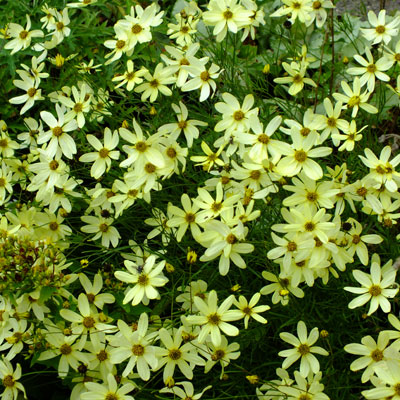
Potsize - 1L
Prolifically produced lemon-yellow daisies on a neat bushy plant 20" (50cm) high. It is tolerant of Summer heat and makes a reliable long-lived plant which is reasonably drought tolerant. It has a long flowering season which can be extended still further by trimming back the tips of the branches, thereby removing the first seeds. It will reward you with a second flush of growth and flowers. It is these seeds that give Coreopsis its common name as they are said to resemble ticks (koris=bug, opsis=like). Easy and much more tolerant of British Winters than the red selections, which need excellent drainage. 12-18" (30-45cm), loved by bees. July-September, full sun.Discount of 25p per plant for quantities of 3 or over -
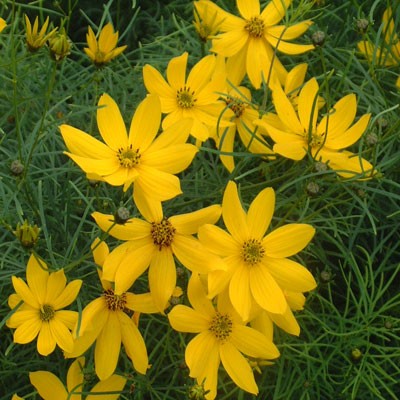
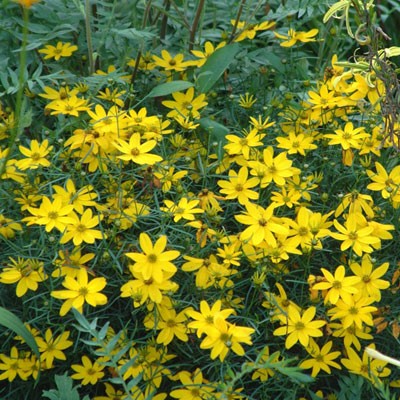
Potsize - 1L
Tickseed. Coreopsis 'Zagreb' is guaranteed to bring its own sunshine to your jaded late Summer border with its myriad of golden-yellow daisies which stud the compact dome from July to September. C.'Zagreb' is a dwarf selection of C. verticillata and shares its dainty habit with wiry stems clothed in glossy needle-like leaves. It is tolerant of Summer heat and makes a reliable long-lived plant which is reasonably drought tolerant. It has a long flowering season which can be extended still further by trimming back the tips of the branches, thereby removing the first seeds. It will reward you with a second flush of growth and flowers. It is these seeds that give Coreopsis its common name as they are said to resemble ticks (koris=bug, opsis=like). Easy and much more tolerant of British Winters than the red selections, which need excellent drainage. 12-18" (30-45cm), loved by bees. July-September, full sun.Discount of 25p per plant for quantities of 3 or over -

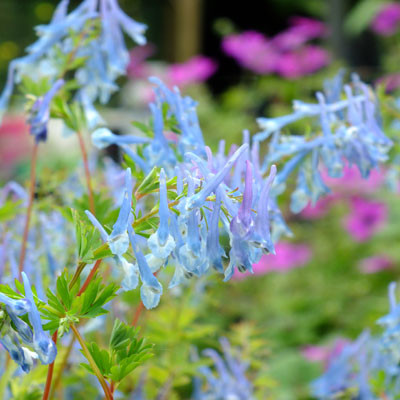
Potsize - 1L
A cross between Corydalis fleuosa and Corydalis omeniana from Ian Young's garden in Aberdeen. Vigorous clumps of limey, chartreusy-green juicy fern-like foliage over which come the strongly scented sky-blue flowers. Like Corydalis elata, but smaller and colouring only very slightly in the stems. Wintergreen and very hardy if grown in a moisture retentive soil which is not over wet and doesn't dry out in the Summer. Divide every three years to maintain vigour and encourage the best flowering. Flowers from Spring until June. 30cmLinks
Corydalis Compared
-
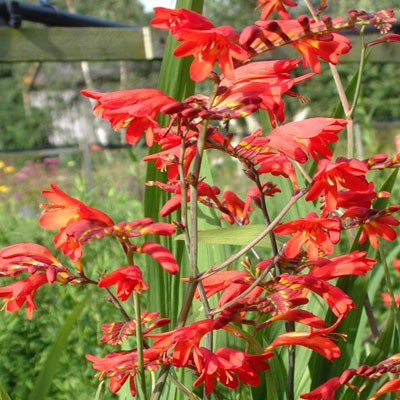
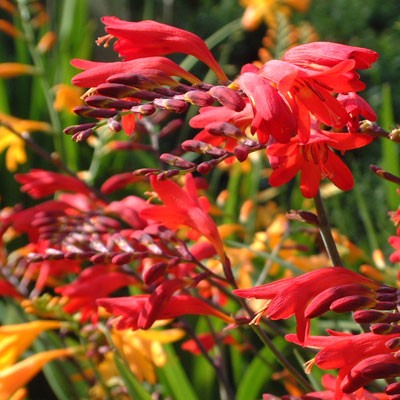
Potsize - 1L
Crocosmia 'Emberglow'. 1970. Crocosmia potsii x Crocosmia paniculata. 90cm This is a tall and imposing crocosmia with strong upright form and flower stems that branch and arch over at the top with rows of red trumpets arrayed each side. Flowers are produced in the form of C.potsii in a dark true red, one of the darkest. Sets seed readily – the seed heads making a lovely winter decoration.Discount of 25p per plant for quantities of 3 or overLinks
Crocosmias compared
-

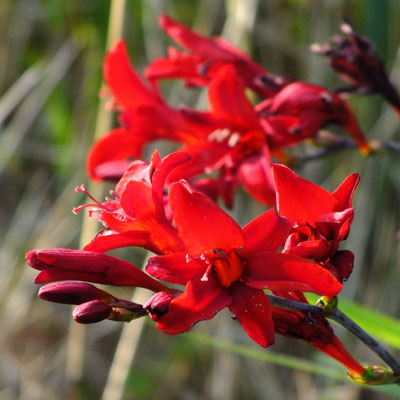
Potsize - 1L
Aptly named, this has to be one of the best new red Crocosmias. Intensely vermillion red, the wide petalled big flowers have no hint of orange, while the throat burns even darker. The narrow pleated leaves are upright rather than floppy and are not as tall as the old Lucifer, nor as inclined to spread. Flowering at 90-120cm in July and August and into September these blooms prefer a not-too-dry position and are very effective in 'hot' schemes.Discount of 25p per plant for quantities of 3 or overLinks
Crocosmias compared
-
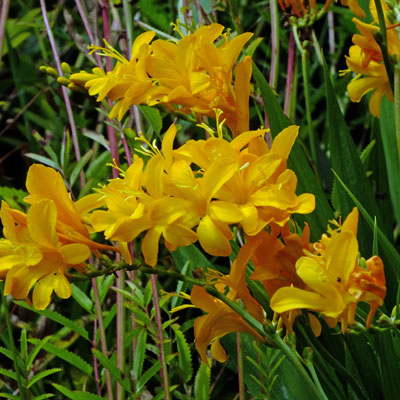
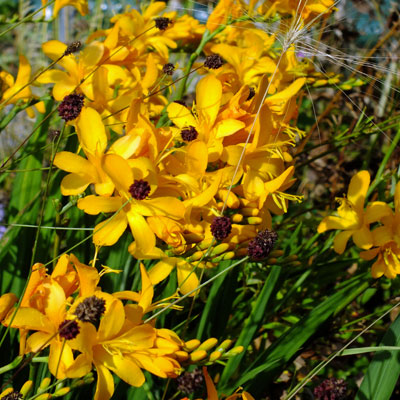
Potsize - 1L
A real beauty with good densely packed spikes of large flowers in deep, mellow golden yellow with a velvety texture. The buds are closely packed in curved reminiscent of a large golden freesia. Clumps of long sword-like foliage are rich green and vigorous. A floriferous variety which grows around a metre tall. Best grown in average to moist conditions, avoiding dry soils. Bred by Ken Ridgely in South Africa. August-September.Discount of 25p per plant for quantities of 3 or overLinks
Crocosmias compared
-
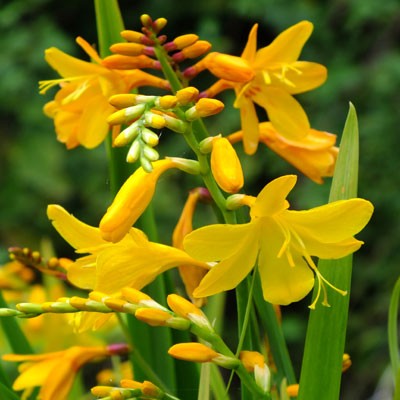
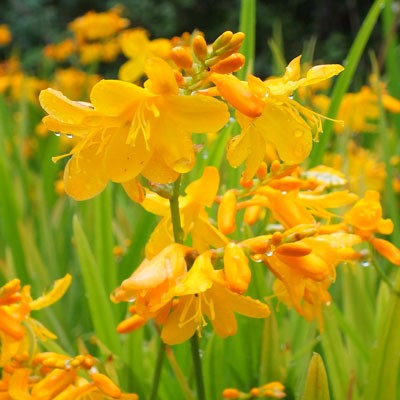
Potsize - 1L
Crocosmia x crocosmiiflora 'Buttercup'. A lovely compact Montbretia with good sized warm apricot-yellow flowers, 35mm across, which open flat. They are borne on shorter stems to 60cm. A rich shot of colour for the late summer garden. For sun or part shade. Introduced in 1995. A robust grower. Compare this to C.'Lady Hamilton' and you will see they are similar with C.'Buttercup' being green in stem and calyx.Discount of 25p per plant for quantities of 3 or overLinks
Crocosmias compared
-

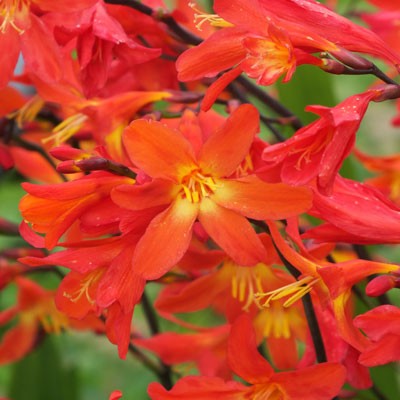
Potsize - 1L
Crocosmia x crocosmiiflora 'Carmin Brilliant'. A relatively short montbretia (40cm) with crimson starry flowers with yellow centre. Good clump forming variety. Hot sunny spot; moist but with good winter drainage. Introdued in 1950. AGM. This variety was previously wrongly sold by the Dutch trade as ‘James Coey’Discount of 25p per plant for quantities of 3 or overLinks
Crocosmias compared
-
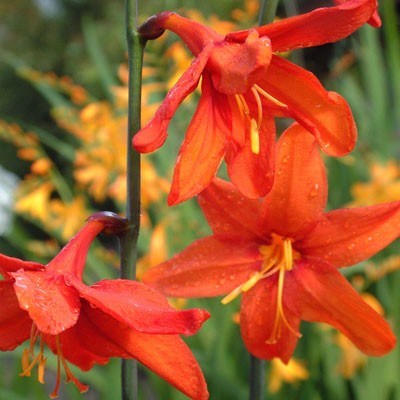
Potsize - 1L
Crocosmia x crocosmiiflora 'Constance'. This variety has large warm orange flowers with lovely yellow centres. Each flower flares good and flat with broad petals, each darker on the reverse. Growth is vigorous with flowering stems to 2' (60cm) high. They enjoy full sun and moisture retentive but well drained conditions. Introduced 1993Discount of 25p per plant for quantities of 3 or overLinks
Crocosmias compared
-
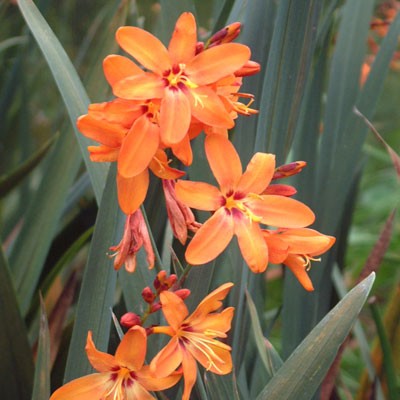
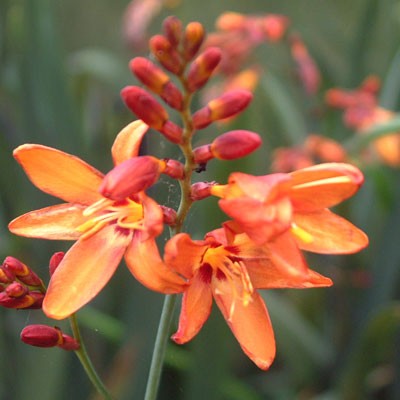
Potsize - 1L
1989. One of the shorter varieties at just 60cm tall. The overall effect is muted and sober with sombre dark bronze leaves that set off beautifully the flowers which are orange, stained with distinct rust spots at the throat and lightened with yellow veins down the centre of the petals and bright yellow stamens. Darker buds complete the picture.Discount of 25p per plant for quantities of 3 or overLinks
Crocosmias compared
-
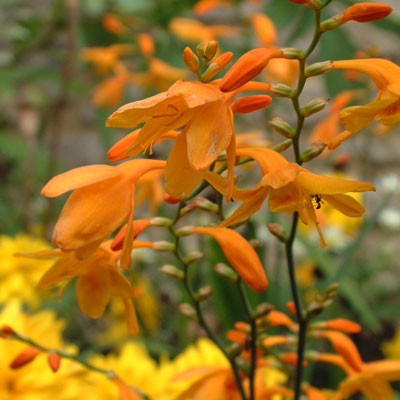

Potsize - 1L
Crocosmia x crocosmiiflora 'George Davison'. A relatively short and lovely montbretia (40cm) with yellow starry flowers. It is also one of the first to flower.. This plant, carrying the name of the first significant breeder of Crocosmia in England, has a confused history. The plant we now grow is actually the original ‘Norwich Canary’, a short cultivar in a warm rich orange yellow, opening from apricot buds. It is vigorous and free to flower. The original cultivar, now possibly lost, was introduced in 1900 ‘Golden Sheaf’ x (crocosmia x crocosmiiflora ‘Golden Sheaf’) and was Large, early, golden yellow, 8-10 branched. Vigorous. 90cm. The plant now sold as ‘George Davison’ are actually the original ‘Norwich Canary’, a shorter cultivar in a warm rich orange yellowDiscount of 25p per plant for quantities of 3 or overLinks
Crocosmias compared
-
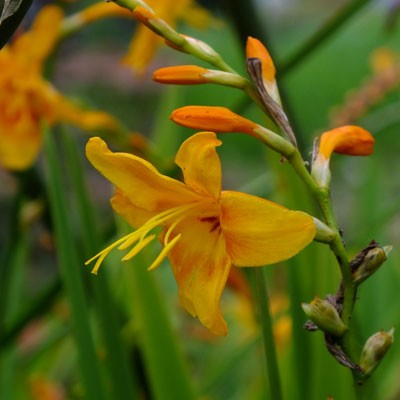
Potsize - 1L
Named after Lord Nelson's lover, this is one of the varieties bred by George Davison, the first breeder of Crocosmias. It has a similar colouring to C.'Buttercup', with the main difference being the red calyces and coloured stems. The spikes are very upright and tightly packed with outward facing blooms in a rich warm yellow, very much enhanced by the red calyces and apricot buds. 60cmDiscount of 25p per plant for quantities of 3 or overLinks
Crocosmias compared
-
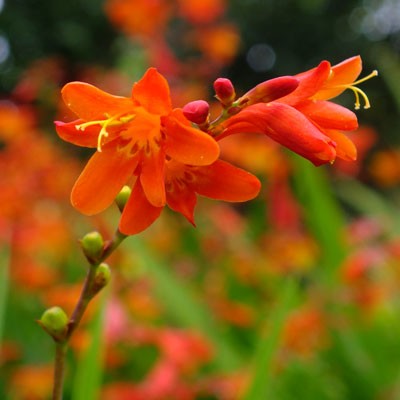
Potsize - 1L
Crocosmia x crocosmiiflora 'Red King'. One of the shorter montbretia (50-70cm) with smaller flowers, in a two tone red and warm yellow, produced in great profusion. Hot sunny spot; moist but with good winter drainage. 1926Discount of 25p per plant for quantities of 3 or overLinks
Crocosmias compared
-
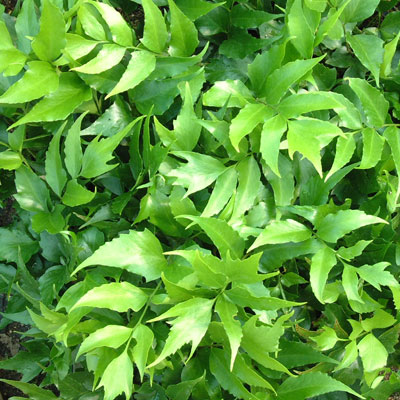
Potsize - 1L
The deep glossy forest green fronds of this fern with its broadly pinnate pseudo-holly foliage makes a wonderful focal point amongst its lacy cousins or a fine evergreen for shade in its own right. It grows to 75cm (30") and can look handsome all year, especially if protected from bitter winds. Good even in deep shade given woodsy friable soil. It will burn if grown in full sun. native of Asia (Korea, China, Vietnam and Thailand and especially Japan where it makes its home in a wide range of environments from urban walls to forest floors.Discount of 25p per plant for quantities of 3 or overLinks
Ferns - Garden Pictures
Ferns for Moist Sites
Ferns for Dry Sites
Ferns - Deciduous or Evergreen
-



RHS AGM
Potsize - 1L
The beautiful Bleeding Heart or Lady-in-the-Bath. Fresh green ferny foliage above which arch stems dripping pink & white flowers like dewdrops. A picture of poise and grace. 3ft in a nice moist soil. The fleshy roots are delving and brittle so its best not disturbed and best sited in a sheltered situation in sun or partial shade with plenty of humus. In hot situations where water might go short at the roots, the plant will take a period of Summer dormancy but will re-emerge the following Spring. Mulching helps to extend the flowering season. Great cut flower and surprisingly scented. Deer and Rabbit resistant, possibly on account of its yellow sap. You know a plant has been loved for years when it has numerous names. For this one try Bleeding Hearts or Ladies-in-the-Bath, Ladies-in-a-boat or Dutchman's Breeches or even Lady's Locket and Lyre Flower. The ladies-in-the-bath/boat reference is only apparent if you take an open flower, turn it upside down and pull the outer petals apart, then it becomes obvious. Discount of 25p per plant for quantities of 3 or overLinks
Botanical Style Photographs
-
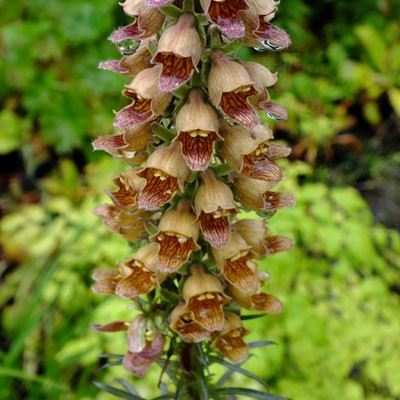
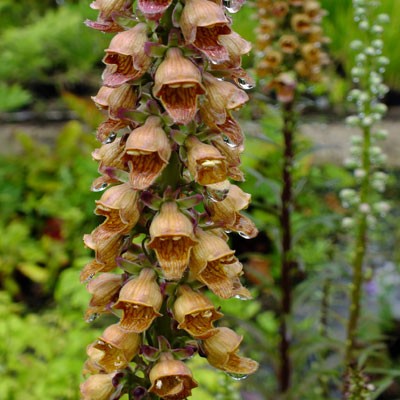
- Bee Friendly
- RHS AGM
Potsize - 1L
Digitalis ferruginea 'Gelber Herold' (Yellow Herald) . Immaculate evergreen glossy rosettes of long, narrow dark green leaves are a feature all year. The flowers spikes are tall, stiff and densely crowded with charming ochre, yellow-lipped flowers arranged all around the stem in perfect regularity. More yellow in the flowers than the species. 4ft CAUTION- TOXIC IF EATENDiscount of 25p per plant for quantities of 3 or overLinks
Foxgloves Compared

















































